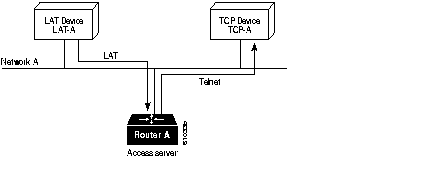This section provides an overview of the products that support protocol translation. You will find the following information in this chapter:
- Protocol translator functionality
- Supported transmission protocols and services
- Supported interfaces and connections
- Physical configuration options
Note In the context of this publication, a router set up to run protocol translation software is referred to as a protocol translator.
Protocol translators are high-performance application-level gateways that can provide connectivity among systems running differing protocols and over a variety of media.
As part of their software capability, protocol translators provide distributed network management facilities to assist in performance monitoring and run-time error logging, and support the Simple Network Management Protocol (SNMP). These facilities enable you to examine and adjust the protocol translators for optimum performance.
Protocol translators translate virtual terminal protocols to allow devices running dissimilar protocols to communicate. The protocol translation software supports Telnet (called TCP for Transmission Control Protocol in the configuration syntax of protocol translation software), Local Area Transport (LAT), and X.25. One-step protocol translation software performs bidirectional translation between any of the following protocols:
- Telnet and LAT
- Telnet and X.25
- LAT and X.25
Figure 1-1 illustrates LAT-to-Telnet protocol translation.

Figure 1-1: LAT-to-Telnet Protocol Translation
Note TN3270 and XRemote are also supported by the protocol translation software.
However, to translate between these and other supported protocols, you must use the two-step method. For information about two-step translations in general, refer to the
Remote Access Server Connection Guide. Refer to the chapters "
Configuring TN3270" and "
Configuring XRemote" later in this publication for task-oriented configuration information about TN3270 and XRemote. Refer to the chapters "
TN3270 Configuration Commands" and "
XRemote Configuration Commands" later in this publication for detailed command descriptions for TN3270 and XRemote.
Protocol translators provide a flexible set of capabilities for making connections using different media and between different hosts and resources running different protocols. The following descriptions summarize the protocols and connection services supported by protocol translators:
- Transmission Control Protocol/Internet Protocol (TCP/IP)--The most widely implemented protocol suite on networks of all media types. TCP/IP is today's standard for internetworking and is supported by most computer vendors, including all UNIX-based workstation manufacturers.
- Local Area Transport (LAT) protocol--Digital Equipment Corporations's proprietary terminal connection protocol used with Digital minicomputers. Router/bridges support bridging of the LAT protocol. Protocol translators translate LAT packets to X.25, Telnet, and TN3270.
- X.25 PAD protocols--Cisco protocol translators support the X.25 protocol and X.3/X.28/X.29 specifications.
- IBM 3278 terminal emulation--The Cisco implementation of TN3270 terminal emulation provides TN3270-based connectivity--specifically, emulation of IBM 3278-2 terminals--to IBM hosts over serial lines.
- Network Computing Devices Inc. XRemote terminal facility--XRemote is a protocol developed specifically to optimize support for X Window operation at a terminal over a serial communications link. XRemote allows for remote X Window operation using an NCD terminal.
In addition to supporting Ethernet (the 802.3 specification of the Institute of Electrical and Electronic Engineers [IEEE]), protocol translators support synchronous serial circuits at many speeds and can be connected to two serial lines. Protocol translator serial interfaces are capable of transmitting and receiving data at up to four megabits per second, and support connectivity to WAN services such as Switched Multimegabit Data Service (SMDS), Frame Relay, and X.25.
A broad line of media adapters are also available for your convenience, including RS-232, V.35, X.21, and RS-449.
This section describes the router models that can be set up to run protocol translation software.
Note In the context of this publication, a router or communication server running protocol translation software is referred to as a protocol translator.
Internetwork Operating System (IOS) Release 10 supports the following router platforms:
- The Cisco 3000 is a two-port multiprotocol router in a fixed configuration with Ethernet, Token Ring, serial, and BRI interface options. BRI is the Integrated Services Digital Network (ISDN) interface composed of two B channels and one D channel for circuit-switched communication of voice, data, and video. The Cisco 3000 comes standard with Flash EPROM and is ideal for use in branch office or remote environments. Protocol translation is provided as a software option, thereby supporting concurrent routing, bridging, and protocol translation capabilities.
- The Cisco 2500 is a two-port multiprotocol router in a fixed configuration with Ethernet, Token Ring, synchronous serial, and ISDN BRI interface options. A variety of protocol translation software feature sets permits the Cisco 2500 to be tailored to the needs of specific remote environments. A Cisco 2500 can also be configured to connect a local SDLC device and a LAN to a corporate internetwork using the second synchronous serial port.
Note Protocol translation is also supported on the
500-CS
and the
ASM-CS
communication server platforms, but the communication server product line is not supported in IOS Release 10.0.
The Cisco products listed in the previous section use either the MC68020, MC68030, or MC68040 microprocessor for high-speed operation. All microprocessors contain onboard RAM, Flash memory, system ROM holding all operating system, bootstrap, and diagnostic software, and hardware and software support for a control console.
Protocol translators also provide nonvolatile memory that retains configuration information despite power losses or system reboots. With nonvolatile memory, the terminal and network servers do not need to rely on other network servers for configuration and boot service information.

